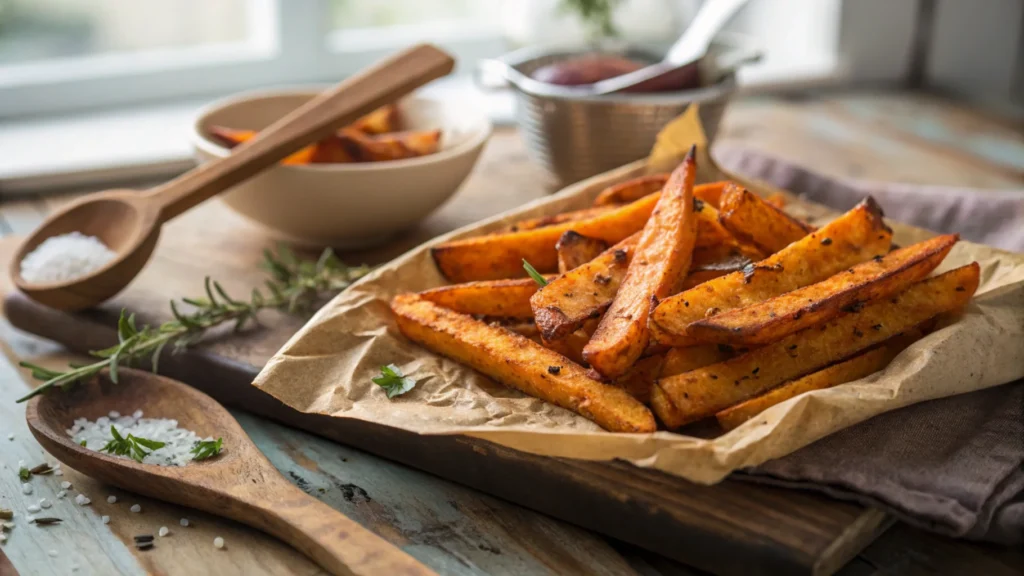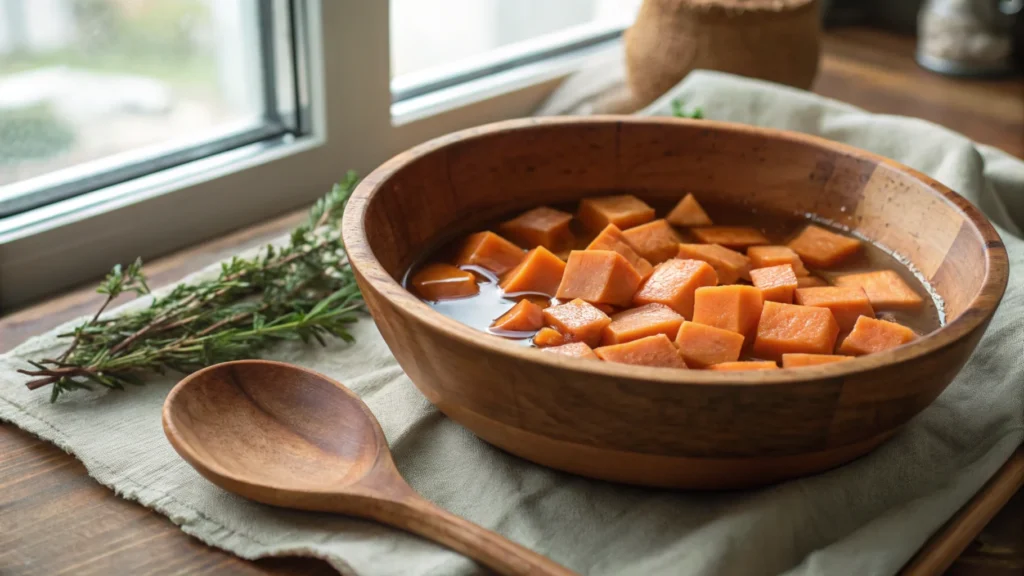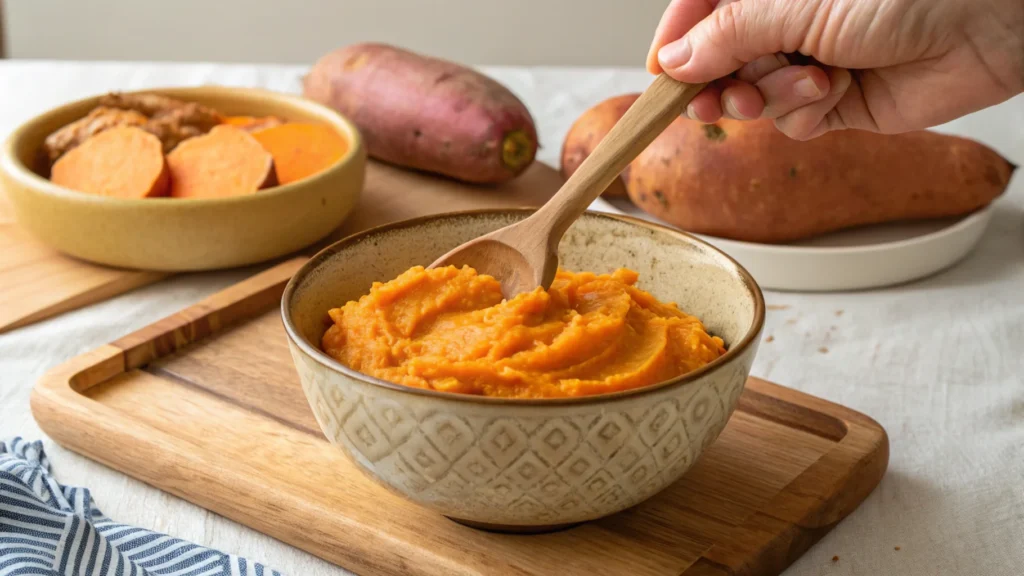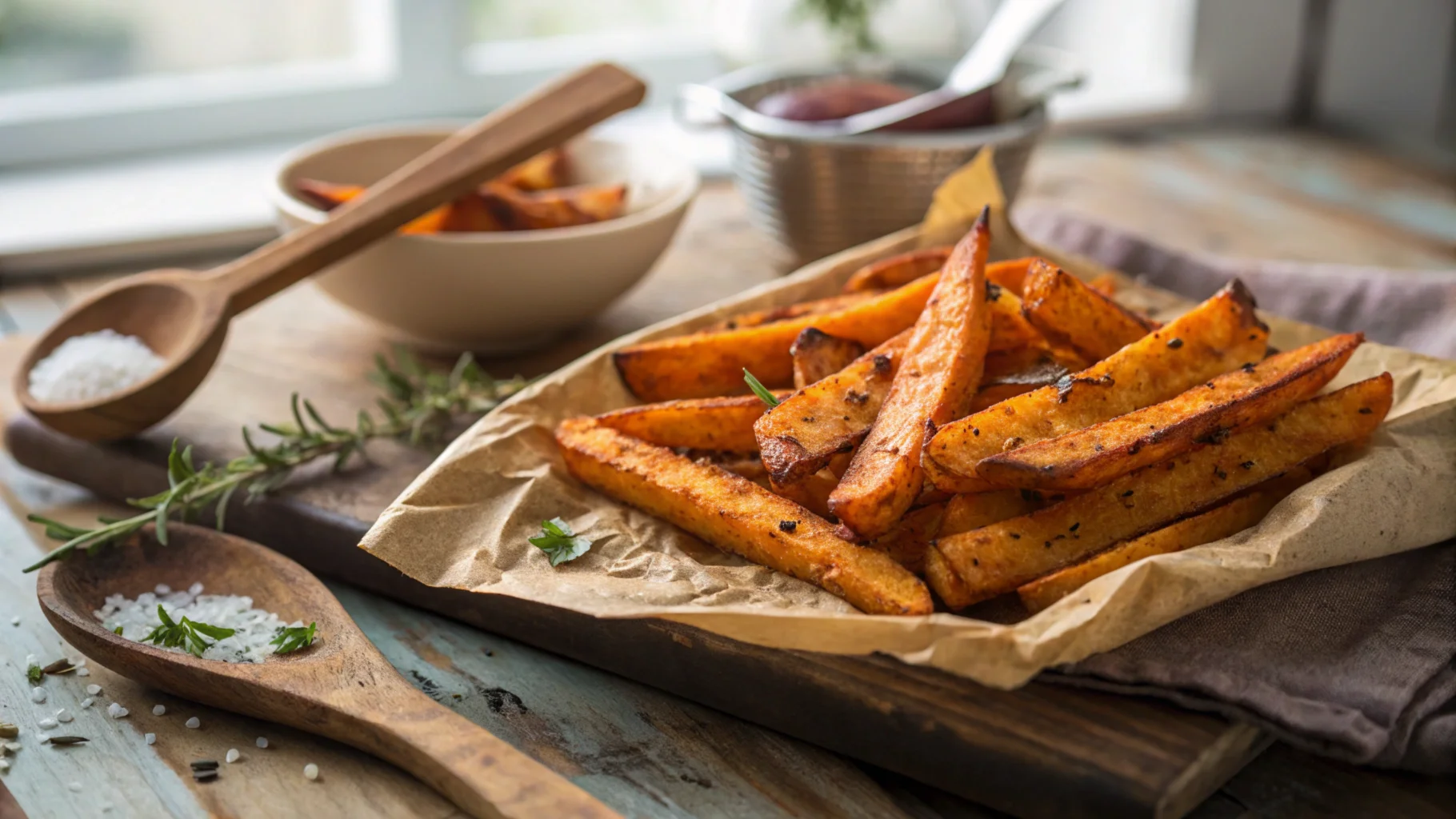Soak sweet potatoes before baking is a simple but effective technique to improve their texture and flavor. Sweet potatoes are naturally rich in starch, which, if left untreated, can lead to a gummy or dense texture. When you soak sweet potatoes, it helps remove this excess starch, resulting in a fluffier, lighter interior. It also softens the sweet potatoes, ensuring they cook more evenly and retain moisture, preventing them from becoming dry during baking.
This step isn’t just about texture—it also enhances the natural sweetness and overall flavor profile of the sweet potatoes. By soaking, you set the stage for a more balanced and delicious dish. Whether you’re baking them whole, making fries, or incorporating them into a recipe, this method ensures optimal results every time.
Want to try a recipe that uses this technique? Check out our Easy Step-by-Step Guide on How to Make Sweet Potato Pie from Scratch. This guide will help you turn soaked sweet potatoes into a flavorful and perfectly baked pie!

Table of Contents
How Soaking Enhances Sweet Potato Texture
Soaking sweet potatoes before baking has a profound impact on their texture. The main reason is the reduction of excess starch, which can create a dry, mealy interior when baked. Soaking removes some starch, making the sweet potato more tender and smoother. This results in a fluffier, creamier texture once baked.
Soaking not only improves softness but also reduces the stringy or fibrous texture that some sweet potatoes may have when cooked. This makes the end product more enjoyable and pleasant to eat. Soaking is an effective step if you want a velvety or smoother sweet potato dish. It enhances the texture during preparation.
Does Soaking Improve Sweet Potato Sweetness?
Many wonder if soaking sweet potatoes before baking increases their natural sweetness. While soaking sweet potatoes primarily removes excess starch and improves texture, it can indirectly enhance sweetness. As starches leach into the water, the remaining sweet potato retains more of its natural sugars. These sugars, unmasked by the starch, make the sweet potato’s natural flavors more pronounced.
Soaking also helps the sweet potato retain moisture, aiding in the caramelization of sugars during baking. This process can enhance the sweetness of the final dish. While the texture improvement is more noticeable, the subtle boost in sweetness is another benefit of soaking.
For more insights on sweet potatoes, check out our guide on Is It Better to Bake or Boil Sweet Potatoes for Pie? | Best Method Explained. It breaks down the best cooking techniques to maximize flavor and texture for your recipes.

The Role of Starch Removal in Soaking
One of the primary reasons Why do you soak sweet potatoes before baking? lies in the process of starch removal. Sweet potatoes are high in starch, which can result in a heavy and dense texture when baked. By soaking them in water, you encourage the starch to break down and leach into the water, leaving the sweet potato flesh lighter and fluffier.
Starch removal plays a crucial role in achieving the desired texture. Without this step, you may end up with a chewy, gummy interior that doesn’t hold up well to baking. Soaking sweet potatoes improves texture and enhances the overall dish quality by reducing excess starch. This process creates a more enjoyable and uniform baked texture.
Time Considerations: How Long Should You Soak?
When soaking sweet potatoes, the amount of time you allow them to soak plays a significant role in achieving the desired results. Typically, soaking sweet potatoes for at least 30 minutes up to 2 hours is ideal for most recipes. The length of soaking time depends on the size of the sweet potatoes and the desired texture. A longer soak helps to ensure more starch is removed, leading to a fluffier interior.
Avoid soaking sweet potatoes for too long, as it may cause them to lose some natural flavors and nutrients. Balancing the soaking time is key to maximizing benefits without compromising taste or nutrition.

Water Temperature: Cold vs. Warm Soaking Methods
The temperature of the water used for soaking sweet potatoes can influence the results. Cold water soaking is the most common method, effectively removing excess starch without softening the potatoes prematurely. This approach preserves the potato’s structure and ensures even cooking.
Warm water, on the other hand, speeds up the starch removal process, which can be useful if you’re short on time. However, it may soften the sweet potatoes too much, potentially compromising their texture. For most recipes, soaking in cold water for 30 minutes to an hour strikes the perfect balance, delivering optimal texture and flavor.
Curious about other culinary insights? Learn How Brioche Is Different from Bread and explore the unique techniques that set this enriched dough apart.
Common Mistakes to Avoid When Soaking Sweet Potatoes
When preparing to soak sweet potatoes, it’s easy to make a few common mistakes that can hinder the effectiveness of the process. Here are a few things to avoid:
- Soaking too long: As previously mentioned, soaking sweet potatoes for too long can lead to a loss of flavor and nutrients. Aim for 30 minutes to 2 hours.
- Not changing the water: If you are soaking for an extended period, make sure to change the water halfway through to prevent excess starch from being reabsorbed.
- Soaking in hot water: Soaking sweet potatoes in too hot of water can cause them to begin cooking before baking, leading to a less desirable texture.
- Not draining properly: After soaking, be sure to drain the sweet potatoes thoroughly to avoid any excess moisture affecting the texture during baking.
By avoiding these mistakes, you can ensure that your sweet potatoes come out of the oven with a perfect texture and flavor.
How Soaking Affects Baking Time and Efficiency
Soaking sweet potatoes not only improves the final product’s texture but also affects the baking time and overall efficiency. When you soak sweet potatoes before baking, they absorb moisture, which allows them to cook faster and more evenly. This is because the water inside the sweet potato aids in the even distribution of heat, helping it cook more quickly without drying out.
Similarly, for mashed sweet potatoes, soaking sweet potatoes is often recommended to achieve a smooth, creamy consistency, but it is not always required, especially if you’re in a hurry. Therefore, whether or not soaking sweet potatoes is necessary depends on the specific dish you’re preparing and the texture you desire.
Comparing Soaked and Unsoaked Sweet Potatoes in Recipes
When it comes to recipes, soaked sweet potatoes and unsoaked sweet potatoes produce different results. In general, soaking sweet potatoes makes them lighter and fluffier due to the removal of excess starch, while unsoaked sweet potatoes tend to be denser and chewier. This makes soaked sweet potatoes ideal for dishes where you want a smooth, creamy texture, such as mashed sweet potatoes or baked sweet potato fries.
Unsoaked sweet potatoes work well for roasted dishes where chewiness is preferred. In such cases, you may not need to soak sweet potatoes. However, if you’re aiming for a fluffier texture, it’s best to soak sweet potatoes. The choice between soaked and unsoaked depends on the dish and the texture you want. For smoother dishes, always soak sweet potatoes. For texture, soak sweet potatoes only if needed. Ultimately, soak sweet potatoes based on your recipe’s needs.
Is Soaking Necessary for All Sweet Potato Dishes?
While soaking sweet potatoes before baking offers numerous benefits, it is not always necessary for every dish. For example, if you’re making roasted sweet potatoes, soaking might not be required, as the roasting process itself can caramelize the natural sugars, producing a tender and flavorful result without the need for soaking.
Similarly, for mashed sweet potatoes, soaking sweet potatoes is often recommended to achieve a smooth, creamy consistency, but it is not always required, especially if you’re in a hurry. Therefore, whether or not soaking sweet potatoes is necessary depends on the specific dish you’re preparing and the texture you desire.
The Impact of Soaking on Nutrient Retention
Soaking sweet potatoes can have some impact on the retention of nutrients, particularly vitamins like Vitamin C and potassium. While soaking helps to remove excess starch, it can also cause a slight leaching of water-soluble nutrients into the soaking water. However, this loss is usually minimal and is far outweighed by the texture and flavor benefits that soaking provides.
To minimize nutrient loss, you can limit soaking time to about 30 minutes to 1 hour. This will help preserve most of the nutrients while still offering the benefits of a smoother texture and reduced starch content. It’s important to remember that the overall nutritional value of baked sweet potatoes remains high, even with slight nutrient loss during soaking.
Tips for Optimal Soaking Practices at Home
To ensure that you’re getting the best results when soaking sweet potatoes, here are some useful tips to follow:
- Use a large bowl: A larger container allows the sweet potatoes to be fully submerged in water, making the soaking process more effective.
- Use filtered water: For the best results, soak your sweet potatoes in clean, filtered water, as this ensures no added impurities affect the flavor.
- Pre-cut sweet potatoes: If you’re working with large sweet potatoes, consider cutting them into smaller pieces before soaking to speed up the process and improve starch removal.
- Drain thoroughly: After soaking, make sure to drain the sweet potatoes well to avoid excess water during baking, which can affect texture.
By following these simple tips, you can maximize the benefits of soaking and enjoy better-baked sweet potatoes every time.
FAQs:
Why are my sweet potatoes still hard after baking?
Sweet potatoes may remain hard after baking for several reasons. One of the most common causes is insufficient baking time. Depending on the size and type of sweet potato, they can take longer to cook. It’s essential to bake them for a sufficient amount of time—typically 45 minutes to 1 hour at 400°F (200°C) for whole sweet potatoes. Another factor could be that the oven temperature is too low or uneven. To ensure they cook evenly, consider testing with a fork or knife to check for tenderness. If they’re still hard, bake them longer or try covering them with foil to retain moisture.
Is it better to soak potatoes before baking?
Yes, soaking potatoes before baking can help improve their texture and baking efficiency. Soaking removes excess starch from the surface, which can contribute to a fluffier interior and crispier skin. It also helps in reducing the gumminess that some potatoes might have when baked. While it’s not necessary for all baking recipes, soaking can be especially useful if you’re aiming for crispy, golden-brown potatoes. Soaking for 30 minutes to 2 hours ensures a lighter texture and quicker, more even cooking.
Why don’t sweet potatoes get crispy?
Sweet potatoes might not get crispy for a few reasons, primarily due to excess moisture. If sweet potatoes are not dried properly before baking, the moisture can cause them to steam rather than crisp up. To achieve a crispy texture, make sure to pat them dry after washing and cutting them. Additionally, using a higher oven temperature (around 400°F or 200°C) can help promote crispiness. Applying a light coating of oil and seasoning also aids in achieving that golden, crispy crust.
Does soaking sweet potatoes make them softer?
Yes, soaking sweet potatoes does make them softer. Soaking helps remove some of the excess starch that can make sweet potatoes dense and firm when baked. By removing this starch, the sweet potato becomes more tender and softer in texture, allowing for a fluffier and creamier interior once baked. Additionally, soaking helps retain moisture, which prevents them from drying out and contributes to an even, soft texture.
Conclusion: When and Why to Soak Sweet Potatoes
Soaking sweet potatoes before baking has a simple yet impactful purpose. It enhances the texture, reduces starch content, and can improve baking efficiency. While not mandatory for every recipe, soaking is highly beneficial for dishes that require a smooth, creamy texture or quicker cooking times.
By soaking your sweet potatoes for the appropriate duration and using the correct water temperature, you can achieve optimal results. Whether you’re preparing mashed sweet potatoes, fries, or other dishes, incorporating soaking into your preparation process will elevate the flavor and texture of your baked sweet potatoes.
For more culinary inspiration, check out this recipe for one-bowl chocolate chip banana bread. It’s a delightful, simple dish that’s perfect for bakers of all levels.

